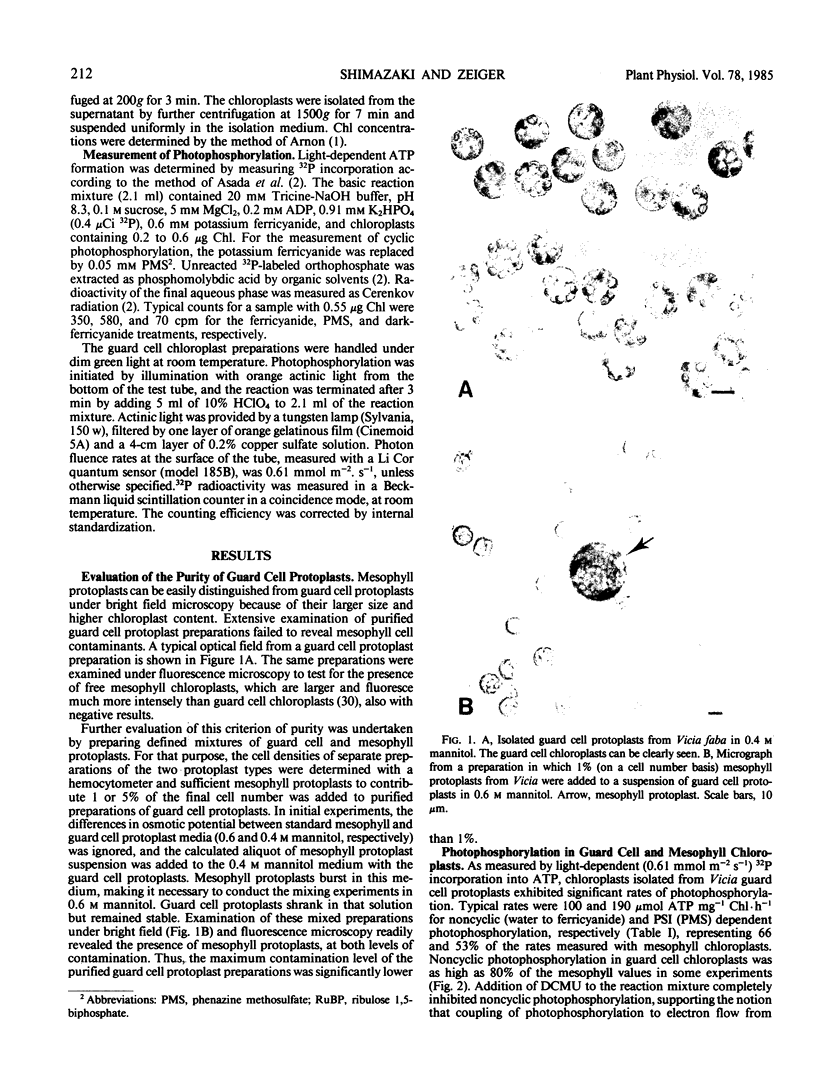Abstract
High rates of both cyclic and noncyclic photophosphorylation were measured in chloroplast lamellae isolated from purified guard cell protoplasts from Vicia faba L. Typical rates of light-dependent incorporation of 32P into ATP were 100 and 190 micromoles ATP per milligram chlorophyll per hour for noncyclic (water to ferricyanide) and cyclic (phenazine methosulfate) photophosphorylation, respectively. These rates were 50 to 80% of those observed with mesophyll chloroplasts. Noncyclic photophosphorylation in guard cell chloroplasts was completely inhibited by 3-(3,4-dichlorophenyl)-1,1-dimethylurea supporting the notion that photophosphorylation is coupled to linear electron flow from photosystem II to photosystem I. Several lines of evidence indicated that contamination by mesophyll chloroplasts cannot account for the observed photophosphorylation rates.
A comparison of the photon fluence dependence of noncyclic photophosphorylation in mesophyll and guard cell chloroplasts showed significant differences between the two preparations, with half saturation at 0.04 and 0.08 millimole per square meter per second, respectively.
Full text
PDF



Images in this article
Selected References
These references are in PubMed. This may not be the complete list of references from this article.
- Arnon D. I. COPPER ENZYMES IN ISOLATED CHLOROPLASTS. POLYPHENOLOXIDASE IN BETA VULGARIS. Plant Physiol. 1949 Jan;24(1):1–15. doi: 10.1104/pp.24.1.1. [DOI] [PMC free article] [PubMed] [Google Scholar]
- Asada K., Takahashi M., Urano M. Phosphorylation assay in liquid scintillation counter using Cerenkov radiation of 32 P: application to photophosphorylation. Anal Biochem. 1972 Jul;48(1):311–315. doi: 10.1016/0003-2697(72)90195-9. [DOI] [PubMed] [Google Scholar]
- Assmann S. M., Zeiger E. Stomatal Responses to CO(2) in Paphiopedilum and Phragmipedium: Role of the Guard Cell Chloroplast. Plant Physiol. 1985 Feb;77(2):461–464. doi: 10.1104/pp.77.2.461. [DOI] [PMC free article] [PubMed] [Google Scholar]
- Grantz D. A., Graan T., Boyer J. S. Chloroplast Function in Guard Cells of Vicia faba L. : Measurement of the Electrochromic Absorbance Change at 518 nm. Plant Physiol. 1985 Apr;77(4):956–962. doi: 10.1104/pp.77.4.956. [DOI] [PMC free article] [PubMed] [Google Scholar]
- Mawson B. T., Franklin A., Filion W. G., Cummins W. R. Comparative Studies of Fluorescence from Mesophyll and Guard Cell Chloroplasts in Saxifraga cernua: Analysis of Fluorescence Kinetics as a Function of Excitation Intensity. Plant Physiol. 1984 Mar;74(3):481–486. doi: 10.1104/pp.74.3.481. [DOI] [PMC free article] [PubMed] [Google Scholar]
- Melis A., Zeiger E. Chlorophyll a Fluorescence Transients in Mesophyll and Guard Cells : MODULATION OF GUARD CELL PHOTOPHOSPHORYLATION BY CO(2). Plant Physiol. 1982 Mar;69(3):642–647. doi: 10.1104/pp.69.3.642. [DOI] [PMC free article] [PubMed] [Google Scholar]
- Ogawa T., Grantz D., Boyer J., Govindjee Effects of Cations and Abscisic Acid on Chlorophyll a Fluorescence in Guard Cells of Vicia faba. Plant Physiol. 1982 May;69(5):1140–1144. doi: 10.1104/pp.69.5.1140. [DOI] [PMC free article] [PubMed] [Google Scholar]
- Outlaw W. H., Manchester J., Dicamelli C. A., Randall D. D., Rapp B., Veith G. M. Photosynthetic carbon reduction pathway is absent in chloroplasts of Vicia faba guard cells. Proc Natl Acad Sci U S A. 1979 Dec;76(12):6371–6375. doi: 10.1073/pnas.76.12.6371. [DOI] [PMC free article] [PubMed] [Google Scholar]
- Outlaw W. H., Mayne B. C., Zenger V. E., Manchester J. Presence of Both Photosystems in Guard Cells of Vicia faba L: IMPLICATIONS FOR ENVIRONMENTAL SIGNAL PROCESSING. Plant Physiol. 1981 Jan;67(1):12–16. doi: 10.1104/pp.67.1.12. [DOI] [PMC free article] [PubMed] [Google Scholar]
- Pallas J. E. Photophosphorylation Can Provide Sufficient Adenosine 5'-Triphosphate to Drive K Movements during Stomatal Opening. Plant Physiol. 1972 Apr;49(4):649–650. doi: 10.1104/pp.49.4.649. [DOI] [PMC free article] [PubMed] [Google Scholar]
- Sharkey T. D., Raschke K. Effect of Light Quality on Stomatal Opening in Leaves of Xanthium strumarium L. Plant Physiol. 1981 Nov;68(5):1170–1174. doi: 10.1104/pp.68.5.1170. [DOI] [PMC free article] [PubMed] [Google Scholar]
- Vaughn K. C., Outlaw W. H. Cytochemical and cytofluorometric evidence for guard cell photosystems. Plant Physiol. 1983 Feb;71(2):420–424. doi: 10.1104/pp.71.2.420. [DOI] [PMC free article] [PubMed] [Google Scholar]
- Willmer C. M., Pallas J. E., Black C. C. Carbon dioxide metabolism in leaf epidermal tissue. Plant Physiol. 1973 Nov;52(5):448–452. doi: 10.1104/pp.52.5.448. [DOI] [PMC free article] [PubMed] [Google Scholar]
- Zeiger E., Armond P., Melis A. Fluorescence Properties of Guard Cell Chloroplasts: EVIDENCE FOR LINEAR ELECTRON TRANSPORT AND LIGHT-HARVESTING PIGMENTS OF PHOTOSYSTEMS I AND II. Plant Physiol. 1981 Jan;67(1):17–20. doi: 10.1104/pp.67.1.17. [DOI] [PMC free article] [PubMed] [Google Scholar]
- Zeiger E., Field C. Photocontrol of the Functional Coupling between Photosynthesis and Stomatal Conductance in the Intact Leaf : Blue Light and Par-Dependent Photosystems in Guard Cells. Plant Physiol. 1982 Aug;70(2):370–375. doi: 10.1104/pp.70.2.370. [DOI] [PMC free article] [PubMed] [Google Scholar]
- Zeiger E., Hepler P. K. Blue light-induced, intrinsic vacuolar fluorescence in onion guard cells. J Cell Sci. 1979 Jun;37:1–10. doi: 10.1242/jcs.37.1.1. [DOI] [PubMed] [Google Scholar]



